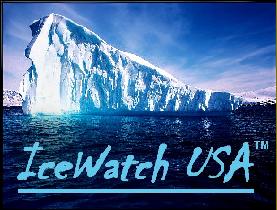
Getting Started IceWatching

Step 1 - Sign up to be a Nature Abounds
Step 2 - Select an observation point that can be used each season and in future years and enter a complete
| IceWatch USA | Become an IceWatcher | Why IceWatch? | Getting Started |
| IceWatch FAQ | IceWatching Tips | Volunteer Application |
Step by Step - Getting Started as an IceWatch volunteer
1. Select a waterbody location
Almost any waterbody is suitable for study. Waterbodies that are not as good for ice observations are: skinny lakes that run parallel to prevailing winds and are heavily influenced by air and wave movement; Lakes and rivers that are heavily controlled by dams - especially dams operated for hydroelectric facilities - or are affected significantly by upstream water control.
2. Select an observation point
Select an observation point that can be used each season and in future years. It should be readily identifiable so you or the next IceWatch USA contributor can easily find it and repeat the observations for many years to come. For small lakes a location with a view of all or most of the lake surface is preferable. For large lakes, or lakes with convoluted shorelines, a location that allows observation of a readily identifiable portion of the lake surface is preferable. This could be an arm of a separate basin of a large lake. For rivers, an observer should simply be able to see a fairly straight stretch of a gently flowing river that is free of restrictions. On both lakes and rivers select a site that is unaffected by local human influences such as dams, sewage or industrial outlets (currents from these outlets can affect ice thickness and therefore ice breakup for some distance downstream), or agricultural influences such as cattle watering areas, or fish farming operations where aerators are used to keep open water available.
3. Select the part of the waterbody you are going to observe
Your observation area could be an entire lake, the middle of a lake, a bay in a lake, or a stretch of river visible from a building, or road location, or any other easily identifiable location. It should be clearly defined so that someone could read your records and continue your observations at exactly the same location. Please remember to accurately describe the location from which you are making the observations. For example, "My observation point is looking south from the upper parking lot at New Providence Beach." Make sure you keep your observation point consistent! If possible, please submit a photo of your waterbody and observation point.
4. Record site description
Your site description only needs to be submitted once per site. However, if you change your site, or if something changes at your site, you'll need to submit a new one. On the site description you will give a name to your site and that will be the name you need to fill in on your observation forms so that the data gathered is properly recorded into the database.
5. Watch for snow, ice and wildlife, and then collect your observations IceWatch USA would like to know the following:
- The date of your observation,
- Time of observation,
- Air temperature on the dates you observe changes,
- Past 24 hour precipitation amount and type (inches / type),
- What percentage looking from your site point across the waterbody is covered with ice range from 0 (none) to 100 (completely frozen over),
- Wildlife seen, heard, tracks, or anything else you feel is worthy of a note,
- The date the ice completely disappears from the lake, bay or river, often referred to as "Spring Thaw",
- Sign, date, file (your copy) and send in a copy of your observations to us for inclusion in the IceWatch USA database.
6. Record your observations on the Observation Form
Accurately record your observations on the IceWatch USA Observation Form. File paper copies of your observations where you or another observer can find them next season.
7. Submit your observations to the IceWatch USA Coordinator
through the on-line system.